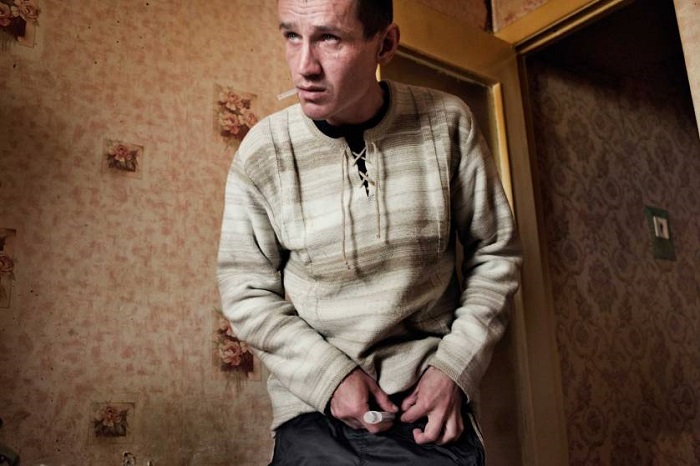Oxana has now stopped using the drug known as krokodil. Yekaterinburg, Russia.
After her husband, pictured here in a wedding photograph, died from drug abuse Oxana and her son went to live with her parents. Yekaterinburg, Russia.
Oxana has been confined to a bed for more than 18 months after her use of the drug known as krokodil damaged her muscles. Photographer Emanuele Satolli first met Oxana in 2013 when she was still using the drug. Yekaterinburg, Russia.
Early this spring, when the snow began to melt in the Russian city of Yekaterinburg, the photographer Emanuele Satolli went knocking on apartment doors in the Uralmash district, a grimy neighborhood in the north of the city. He knew many of its hallways by heart. This was the place he’d gone in 2013 to photograph young men and women addicted to a synthetic drug known as krokodil. Three years later, he came back to find them again. But their old haunts and cookhouses were mostly deserted.
Krokodil, a cheap substitute for heroin, was one of the deadliest designer drugs ever to sweep through Russia. Appearing on the black market in the early 2000s, it wound up ensnaring hundreds of thousands of addicts across the country, and it spread especially fast in poor, industrial areas like Uralmash.
Its appeal was simple: addicts could easily learn to cook it in their kitchens using ingredients purchased at local pharmacies and hardware stores, among them hydrochloric acid, paint thinner and red phosphorous, which they scraped from the sides of match boxes. For a fraction of the price of heroin, the drug produced a similar high and was just as addictive.
But the damage it caused was far more gruesome and often irreversible. The addict’s flesh at the injection site would often rot away, while the tissues of the brain and other vital organs were severely eroded. “So my expectation was to find that some of them had died,” Satolli says of his trip to find the addicts in Yekaterinburg this year. “But not so many.”
Of the ten krokodil users Satolli had photographed in 2013, ranging in age from 30 to 43 at that time, three of them were dead by the time he came back this year. Extensive research and interviews with the friends and neighbors of four other addicts from Satolli’s list failed to turn up their whereabouts. “They disappeared,” says the photographer, and among those who knew them, they are usually presumed to be dead.
Of the three former addicts Satolli found alive, one was in the tuberculosis ward in a local hospital; another had been bedridden for two years and unable to leave her apartment. Only one of the recovering addicts Satolli tracked down, a man in his early 30s named Pavel, had managed to kick the habit without sustaining crippling damage to his health.
Photographing them presented a peculiar set of challenges. Three years ago, the hardest part of producing the series for TIME LightBox was to win enough trust to be invited into the kitchens where the addicts cooked krokodil and the shabby apartments they used to shoot up. “The challenge was not to make a cliché picture of an addict with a needle in the arm,” he says. “I tried to respect them, to show that they were more than just drug addicts, to show their whole lives.”

Alexei, age 33, injects a dose of krokodil. Because of his dependence on krokodil, Alexei has injuries and swelling around his feet and is forced to walk with a cane.
A stage of krokodil preparation. Pills of codeine are crushed and mixed with iodine, hydrochloric acid and other chemicals.
Olya, 35 years old, injects krokodil.
Pavel, 31 years old, shows the effects of the krokodil on his skin. The chemicals used to prepare krokodil cause deep wounds and sores.
The following photographs were taken in Yekaterinburg, Russia in 2013.
Alexei, age 33, injects a dose of krokodil. Because of his dependence on krokodil, Alexei has injuries and swelling around his feet and is forced to walk with a cane.
But the production of his follow-up series on krokodil was in many ways more difficult. It forced Satolli to ask himself: “How can I represent the deaths, the empty places?”
Sometimes the answer was clear. At the city’s crematorium, he was able to access the records of addicts who had died, as well as the names of the relatives who had identified their bodies. Some of those family members then took Satolli to see their graves, which were decorated with the photos of their young faces staring somberly out at the snow.
But beyond that, the photographer was left to ring a lot of doorbells while looking for the remnants of the other addicts’ lives. “A lot of people were suspicious, especially old people who [grew up] in the Soviet Union,” he says. Many would stare at him through their peepholes or open a crack in the door before sending Satolli away.
All of the cookhouses and drug dens he had visited in 2013 were either empty or occupied by other tenants – a sign of the fact that krokodil has, thankfully, fallen out of favor in Russia.
Its decline came almost as suddenly as the epidemic that it caused. In the first three months of 2011, the country’s counter-narcotics agency said it had seized around 65 million doses of the drug, a 23-fold increase from 2009. The agency then lobbied for the government to impose a ban on the over-the-counter sale of codeine, the main ingredient in krokodil. By 2014, two years after the ban took effect, federal authorities announced that the drug had been practically eradicated from the streets.
Watch Emanuele Satolli’s video report from 2013
In the stairwells of Uralmash, Satolli still found it lurking earlier this year. He says he noticed the distinctive, acrid stink that the cooking process of krokodil produces coming from a kitchen, and the man living in that apartment admitted that he still makes the drug from time to time. But other synthetic drugs, such the ones known in the streets as bath salts, now dominate the market in Russia, while the most common sign of krokodil is the quiet devastation it has left behind.
















































